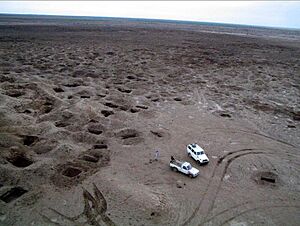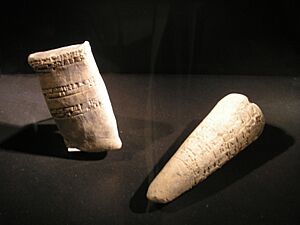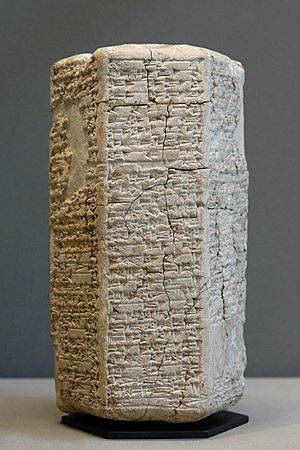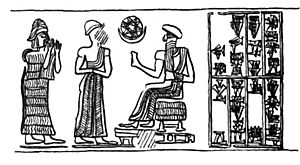Isin facts for kids
| [[File::None at this time|frameless]] | |
| Alternative name | Ishan al-Bahriyat |
|---|---|
| Location | Al-Qādisiyyah Governorate, Iraq |
| Region | Mesopotamia |
| Coordinates | 31°53′06″N 45°16′07″E / 31.88500°N 45.26861°E |
| Type | Settlement |
| History | |
| Periods | Early Dynastic, Isin-Larsa, Old Babylonian, Kassite, Neo-Babylonian |
| Site notes | |
| Excavation dates | 1924, 1926, 1973-1989 |
| Archaeologists | Stephen Herbert Langdon, Raymond P. Dougherty, Barthel Hrouda |
Isin was an important ancient city in Mesopotamia, located in what is now Iraq. People lived there for a very long time, from around 3000 BC until about 500 BC. It was a big city, about 40 kilometers (25 miles) southeast of the modern city of Al Diwaniyah.
The main god of Isin was Gula, the goddess of healing. She had a huge temple in the city. There were also smaller temples for other gods connected to healing, like Ninisina and Sud.
Contents
Exploring Ancient Isin
The ancient city of Isin is located about 32 kilometers (20 miles) south of another old city called Nippur. The site is very large, covering about 150 hectares (370 acres). It has tall mounds, up to 10 meters (33 feet) high, where the ancient buildings once stood.
Archaeologists first visited Isin in the 1920s. Stephen Herbert Langdon and Raymond P. Dougherty found special bricks with writing on them. These bricks had the names of ancient kings like Ishme-Dagan and Nebuchadnezzar II.
More detailed archaeological digs happened between 1973 and 1989. A team from Germany, led by Barthel Hrouda, worked there for many years. They found hundreds of clay tablets with cuneiform writing. These tablets were from the Old Babylonian period and were found in buildings that had been destroyed by fire.
One exciting discovery was an alabaster mace head (a type of weapon) from the Akkadian Empire. It had the name of King Manishtushu carved on it. They also found a small stone lion statue from a very early period called the Uruk period.
The archaeologists spent a lot of time exploring the huge temple complex dedicated to the healing goddess Gula. This temple was built and rebuilt many times over centuries. Inside the temple, they found 30 dog burials, copper pendants shaped like dogs, and clay dog statues. Dogs were special to Gula, as they were seen as symbols of healing. One clay dog even had a prayer to Gula written on it!
The Story of Isin
Isin was first settled during the Ubaid period, which was a very long time ago. It became a truly important city during the Early Dynastic period, around 3000 BC. It was also part of the powerful Akkadian Empire.
After the great Ur III empire fell, around 2000 BC, a new group of people called the Amorites took control of Isin. This started the First Dynasty of Isin.
The First Dynasty of Isin
The first king of Isin was Ishbi-Erra. He was an official from the Ur III empire. When the Elamites attacked and captured the city of Ur, Ishbi-Erra helped drive them out. This made him a hero and helped him become king of Isin.
The First Dynasty of Isin lasted for over 200 years. At first, Isin was very powerful. Kings like Ishme-Dagan were famous, and many hymns (special songs or poems) were written about them.
Isin's Challenges
Over time, Isin faced many problems. Other cities, especially Larsa, grew stronger. Isin also had trouble getting enough water because its canals were rerouted by its enemies. The city of Ur, which was important for trade, was also lost to Larsa.
Around 1860 BC, a new ruler named Enlil-bani took the throne. This ended the original family line of kings that Ishbi-Erra had started. Even though it was weaker, Isin managed to stay independent from Larsa for another 40 years. Eventually, the ruler of Larsa, Rim-Sin I, took control of Isin.
Later, the city of Babylon became very powerful. After Babylon captured Larsa, they also built new structures in Isin. However, these buildings were later destroyed around 1750 BC.
Later Periods
After a period of quiet, the Kassites (another group of people who ruled Babylon) started building in Isin again. During this time, Isin was mainly a religious center, especially for the Gula temple. The city continued to be occupied, though less important, until at least the time of the Persian ruler Darius I, around 500 BC.
Rulers of Isin
Here are some of the important rulers from the First Dynasty of Isin:
| Picture | Ruler | Approximate dates of reign | Notes |
|---|---|---|---|
| First Dynasty of Isin (around 2018-1791 BC) | |||
| Ishbi-Erra | c. 2018–1985 BC | Helped defeat the Elamites | |
| Shu-Ilishu | c. 1985–1975 BC | Son of Ishbi-Erra | |
| Iddin-Dagan | c. 1975–1954 BC | Son of Shu-Ilishu | |
| Ishme-Dagan | c. 1954–1935 BC | Son of Iddin-Dagan, many hymns written about him | |
| Lipit-Ishtar | c. 1935–1924 BC | Known for his law code | |
| Ur-Ninurta | c. 1924–1896 BC | ||
| Bur-Suen | c. 1896–1874 BC | Son of Ur-Ninurta | |
| Lipit-Enlil | c. 1873–1869 BC | Son of Bur-Suen | |
| Erra-imitti | c. 1869–1861 BC | ||
| Ikūn-pî-Ištar | c. 1861–1860 BC | ||
| Enlil-bani | c. 1860–1837 BC | Not from the original royal family | |
| Zambiya | c. 1837–1834 BC | ||
| Iter-pisha | c. 1834–1831 BC | ||
| Ur-du-kuga | c. 1831–1828 BC | ||
| Suen-magir | c. 1827–1816 BC | ||
| Damiq-ilishu | c. 1815–1791 BC | Son of Suen-magir, last king of the First Dynasty | |
Daily Life and Culture
Isin was located on the Isinnitum Canal, which was part of a network of waterways connecting cities in Mesopotamia. This was important for travel and trade.
The kings of Isin continued many traditions from earlier empires. They wanted to keep a good relationship with the gods, believing this would bring peace and wealth to their land. For example, they kept the practice of appointing their daughters as special priestesses of the moon god in Ur.
Literature also continued to be important. Royal hymns, which were poems praising the kings, were still written. These hymns often copied the style and language of older poems from the Ur III period. Some hymns were written as if the king himself was speaking, while others were prayers from ordinary people to their king.
During this time, the Sumerian King List was completed. This list recorded many ancient kings, some legendary and some real. By linking the Isin Dynasty to these older kings, it helped make their rule seem more legitimate and powerful to the people.
See also
- Cities of the Ancient Near East
- List of Mesopotamian dynasties






